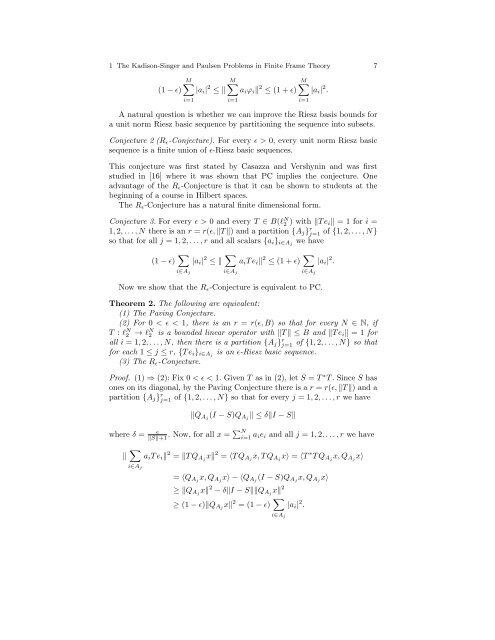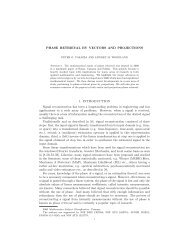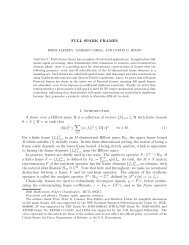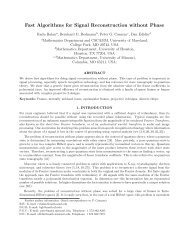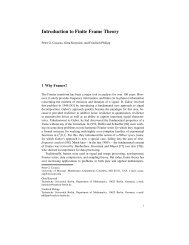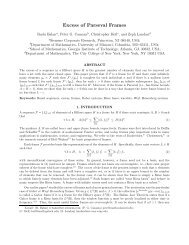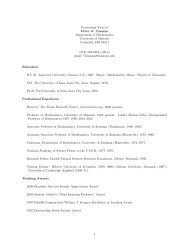The Kadison-Singer and Paulsen Problems in Finite Frame Theory
The Kadison-Singer and Paulsen Problems in Finite Frame Theory
The Kadison-Singer and Paulsen Problems in Finite Frame Theory
You also want an ePaper? Increase the reach of your titles
YUMPU automatically turns print PDFs into web optimized ePapers that Google loves.
1 <strong>The</strong> <strong>Kadison</strong>-<strong>S<strong>in</strong>ger</strong> <strong>and</strong> <strong>Paulsen</strong> <strong>Problems</strong> <strong>in</strong> F<strong>in</strong>ite <strong>Frame</strong> <strong>The</strong>ory 7M∑M∑M∑(1 − ɛ) |a i | 2 ≤ ‖ a i ϕ i ‖ 2 ≤ (1 + ɛ) |a i | 2 .i=1i=1A natural question is whether we can improve the Riesz basis bounds fora unit norm Riesz basic sequence by partition<strong>in</strong>g the sequence <strong>in</strong>to subsets.Conjecture 2 (R ɛ -Conjecture). For every ɛ > 0, every unit norm Riesz basicsequence is a f<strong>in</strong>ite union of ɛ-Riesz basic sequences.This conjecture was first stated by Casazza <strong>and</strong> Vershyn<strong>in</strong> <strong>and</strong> was firststudied <strong>in</strong> [16] where it was shown that PC implies the conjecture. Oneadvantage of the R ɛ -Conjecture is that it can be shown to students at thebeg<strong>in</strong>n<strong>in</strong>g of a course <strong>in</strong> Hilbert spaces.<strong>The</strong> R ɛ -Conjecture has a natural f<strong>in</strong>ite dimensional form.Conjecture 3. For every ɛ > 0 <strong>and</strong> every T ∈ B(l N 2 ) with ‖T e i ‖ = 1 for i =1, 2, . . . , N there is an r = r(ɛ, ‖T ‖) <strong>and</strong> a partition {A j } r j=1 of {1, 2, . . . , N}so that for all j = 1, 2, . . . , r <strong>and</strong> all scalars {a i } i∈Aj we have(1 − ɛ) ∑i∈A j|a i | 2 ≤ ‖ ∑i=1i∈A ja i T e i ‖ 2 ≤ (1 + ɛ) ∑i∈A j|a i | 2 .Now we show that the R ɛ -Conjecture is equivalent to PC.<strong>The</strong>orem 2. <strong>The</strong> follow<strong>in</strong>g are equivalent:(1) <strong>The</strong> Pav<strong>in</strong>g Conjecture.(2) For 0 < ɛ < 1, there is an r = r(ɛ, B) so that for every N ∈ N, ifT : l N 2 → l N 2 is a bounded l<strong>in</strong>ear operator with ‖T ‖ ≤ B <strong>and</strong> ‖T e i ‖ = 1 forall i = 1, 2, . . . , N, then there is a partition {A j } r j=1 of {1, 2, . . . , N} so thatfor each 1 ≤ j ≤ r, {T e i } i∈Aj is an ɛ-Riesz basic sequence.(3) <strong>The</strong> R ɛ -Conjecture.Proof. (1) ⇒ (2): Fix 0 < ɛ < 1. Given T as <strong>in</strong> (2), let S = T ∗ T . S<strong>in</strong>ce S hasones on its diagonal, by the Pav<strong>in</strong>g Conjecture there is a r = r(ɛ, ‖T ‖) <strong>and</strong> apartition {A j } r j=1 of {1, 2, . . . , N} so that for every j = 1, 2, . . . , r we havewhere δ =‖ ∑‖Q Aj (I − S)Q Aj ‖ ≤ δ‖I − S‖ɛ‖S‖+1 . Now, for all x = ∑ Ni=1 a ie i <strong>and</strong> all j = 1, 2, . . . , r we havei∈A ja i T e i ‖ 2 = ‖T Q Aj x‖ 2 = 〈T Q Aj x, T Q Aj x〉 = 〈T ∗ T Q Aj x, Q Aj x〉= 〈Q Aj x, Q Aj x〉 − 〈Q Aj (I − S)Q Aj x, Q Aj x〉≥ ‖Q Aj x‖ 2 − δ‖I − S‖‖Q Aj x‖ 2≥ (1 − ɛ)‖Q Aj x‖ 2 = (1 − ɛ) ∑i∈A j|a i | 2 .


